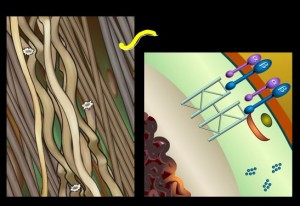 Many BJSM followers know about mechanotherapy – so skip this blog.
Many BJSM followers know about mechanotherapy – so skip this blog.
If you aren’t aware that you know about it, there is a BJSM podcast – here’s the link.
Relevant background — I have a ‘competing interest’ – I’m blogging about a paper I coauthored. It’s my 2nd such post since we started blogging seriously at BJSM (2009). The objective measure is that the paper has been downloaded almost 90,000 times in full text and PDF. And I have been encouraged by colleagues – so here goes…
There is substantial level 1 evidence that exercise is a powerful therapy for musculoskeletal conditions – for muscle strains, joint degeneration, sciatica, tendinopathy. The historical rationale to explain the mechanism was ‘strengthening’.
‘Strengthening’ as a mechanism for tissue repair didn’t make sense to me when I was in my busy clinical phase. How did ‘strengthening’ the hip external rotators remove the pain of ITB friction syndrome? What was it about ‘strength’ that would remove the pain of a hamstring strain? There is more to tissue repair than ‘strength’.
Mechanotransduction is a well-recognized physiological principle that should have much more traction in physiotherapy/physical therapy courses and in sports medicine. This is how the body adapts to load. Why are Arnold Schwarzenegger’s muscles bigger than mine? His workouts signal his cells to hypertrophy and and multiply as needed and he gets bigger muscles. Why does an elite distance runner have larger blood vessels than a sedentary academic about to have a cardiac arrest? Mechanotransduction is the process.
A negligent sawmiller – who has lost his distal phalanx — has a vastly smaller proximal phalanx than his or her proximal phalanges on the intact fingers. Same hand, same genetics — less loading. Mechanotherapy trumps genetics! Note examples from different tissues – mechanotherapy is a universal principle.
When clinicians prescribe exercise, the loading signals cell to repair and to function in response to load. Turning movement into repair.
Clinicians see the power of mechanotherapy daily. Mechanotherapy is when you apply the principle of mechanotransduction as a treatment – analogous to the use of ‘electotherapy’ or ‘pharmacotherapy’ (but way more powerful than either of those!). Medial ligament rehab – how does it work? Mechanotherapy. Normal physiology = mechanotransduction; Prescribing targeted exercise = mechantherapy. Simple.
Mechanotransduction has a very well-established scientific basis underpinning the success. Incontrovertible. (5077 citations in Pubmed). Stick with exercise loading– it can take time to work fully. Avoid the temptation to switch to snake-oil formulas or funky treatments. Trust in millions of year of evolution. The folks who couldn’t heal their own injuries while moving on to the next feeding grounds aren’t with us any more. Mechanotherapy provides a powerful survival benefit!
And I discuss this paper with BMJ MultiMedia editor @HarrietVickers on this podcast link: https://soundcloud.com/bmjpodcasts/bjsm-podcast-mechanotherapy
And you can upload of the graphics from the paper for free as powerpoint slides. If you enjoy the podcast or have tips as to how we can make it better – tweet @BJSM_BMJ
Turning movement into repair!
**BJSM has over 230 podcasts on SoundCloud with over 900,000 listens** Check them out at http://bjsm.bmj.com/site/podcasts/
Professor Michael Kjaer has a great podcast on pathology and treatment options: It’s much better than this mechanotherapy one but don’t tell anyone I said that.